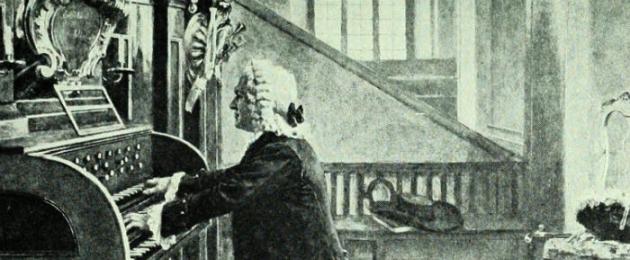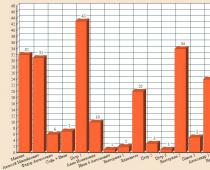Johann Sebastian Bach
In this article you will learn:
Any lover of real music will truly admire this name.
Birth and childhood
The greatest composer was born in 1685, (March 21) into the large family of Johann Ambrosius Bach and his wife Elisabeth. The birthplace of little Johann was the small town of Eisenach (at that time the Holy Roman Empire). Sebastian was the eighth child and also the youngest.
Bach's passion for music was inherent in nature and this is not surprising, because most of his ancestors were professional musicians. Bach's father was also a musician, and at the time of the birth of his eighth son, he organized concerts in Eisenach.
At the age of 9, Sebastian’s mother died, and a year later his father left the world. The elder Bach, Johann Christoph, took on raising his younger brother.
Music lessons
Living with Christophe, Sebastian entered the gymnasium, simultaneously learning music from his brother. Christophe gave him lessons in playing various musical instruments, mainly the organ and clavier.
At the age of 15, the future genius began studying at a vocal school. It bore the name of St. Michael and was located in the city of Luneburg. Bach turned out to be an amazingly capable student. He eagerly learned the basics of musical art, studied the work of other musicians, and developed himself comprehensively. In Lüneburg, Johann wrote his first organ pieces.
First job
After graduating in 1703, the young genius went to serve Duke Ernst in Weimar. He served as a court musician. This responsibility weighed heavily on Bach, and with great relief he changed jobs, receiving the position of organist in the Church of St. Boniface in the city of Arndstadt.
The composer's musical talent began to bring him well-deserved fame.
In 1707, Johann decided to move to the city of Mülhusen, continuing to serve as a church musician in the Church of St. Blaise. The city authorities were very pleased with his work.

Weimar
That same year, Bach married for the first time. The girl's name was Maria Barbara, she was the musician's cousin.
In 1708 the family moved to Weimar. There Johann again began to serve as court organist. In Weimar, a young couple had 6 children, but unfortunately only three survived. All of them later became talented musicians.
It was in Weimar that Bach became famous as a skilled organist and harpsichord master. He absorbed the music of other countries and composed something unimaginable. Even the then famous Louis Marchand, a French organist, refused to compete with him. At this time, Bach created real masterpieces.
Köthen
Tired of Weimar, Bach decided to leave the service. For such a desire, he was even arrested, since the Duke did not want to let the musician go. But, soon, released, Johann went to give his music to the city of Köthen to the Duke of Anthalt-Köthen. This happened in 1717. During this period, the “Well-Tempered Clavier” and the famous “Brandenburg Concertos” were written, the Brandenburg Concertos, English and French suites were composed.
In 1720, while Bach was away, his wife Barbara died.
Bach married a singing star for the second time in 1721. The singer's name was Anna Magdalene Wilhelm. The marriage should be considered happy. The couple had 13 children.

The creative journey continues
In 1723, Bach performed the St. John Passion in the Church of St. Thomas. In the same year, he received the position of choir cantor there, and soon became the “musical director” of all the churches in the city.
The periods of Bach's life in Leipzig are considered the most productive.
The last years of the composer
At the end of his life, Johann Bach was rapidly losing his sight. The capricious public believed that his time had passed, and now he was writing boring and outdated music. And the musician continued to create, despite everything. Thus were born the plays called “Music of the Offering.”
- In contact with 0
- Google+ 0
- OK 0
- Facebook 0








